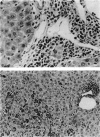Abstract
Experimental autoimmune hepatitis was induced in B10.A(5R) mice sensitized by repeated intramuscular injections of syngeneic liver antigens emulsified with complete Freund's adjuvant. A 300R X-irradiation followed by two more injections after the sixth intramuscular sensitization to the mice resulted in active hepatitis with severe piecemeal necrosis. An intravenous adoptive transfer of spleen cells from the sensitized mice into normal syngeneic mice caused hepatitis in recipients which was characterized by extensive focal hepatic cell necrosis in the lobules. The transfer of spleen cells treated with monoclonal anti-Thy-1.2 antibody plus complement failed to induce hepatitis, while the transfer of T cell-enriched spleen cells by the panning method using rabbit anti-mouse immunoglobulin-coated dishes caused a somewhat more severe hepatitis than that caused by the transfer of whole spleen cells of the sensitized mice.
Full text
PDF








Images in this article
Selected References
These references are in PubMed. This may not be the complete list of references from this article.
- Anderson R. E., Warner N. L. Ionizing radiation and the immune response. Adv Immunol. 1976;24:215–335. doi: 10.1016/s0065-2776(08)60331-4. [DOI] [PubMed] [Google Scholar]
- Bartholomaeus W. N., Reed W. D., Joske R. A. Autoantibody to liver-specific lipoprotein in the mouse: regulation by naturally occurring autoantigen specific suppressor cells. Clin Exp Immunol. 1984 Nov;58(2):307–316. [PMC free article] [PubMed] [Google Scholar]
- Bartholomaeus W. N., Reed W. D., Joske R. A., Shilkin K. B. Autoantibody responses to liver-specific lipoprotein in mice. Immunology. 1981 Jun;43(2):219–226. [PMC free article] [PubMed] [Google Scholar]
- Bartholomaeus W. N., Shellam G. R., Allan J. E., Reed W. D., Joske R. A. Autoantibodies to liver-specific lipoprotein following hepatitis induced by mouse cytomegalovirus. Clin Exp Immunol. 1983 Apr;52(1):89–97. [PMC free article] [PubMed] [Google Scholar]
- Eddleston A. L., Williams R. Inadequate antibody response to hBAg or suppressor T-cell defect in development of active chronic hepatitis. Lancet. 1974 Dec 28;2(7896):1543–1545. doi: 10.1016/s0140-6736(74)90287-6. [DOI] [PubMed] [Google Scholar]
- Feighery C., McDonald G. S., Greally J. F., Weir D. G. Histological and immunological investigation of liver-specific protein (LSP) immunized rabbits compared with patients with liver disease. Clin Exp Immunol. 1981 Jul;45(1):143–151. [PMC free article] [PubMed] [Google Scholar]
- Inada T., Yamamoto H., Bitoh S., Fujimoto S., Hamaoka T. Detection and characterization of idiotype-specific enhancing cells generated in mice immunized with idiotype. J Immunol. 1982 Nov;129(5):2069–2073. [PubMed] [Google Scholar]
- JAHIEL R. I., KOFLER D. Hepatic granulomas induced in guinea-pigs by Freund's adjuvant with and without homologous liver. Br J Exp Pathol. 1961 Aug;42:338–342. [PMC free article] [PubMed] [Google Scholar]
- Kuriki J., Murakami H., Kakumu S., Sakamoto N., Yokochi T., Nakashima I., Kato N. Experimental autoimmune hepatitis in mice after immunization with syngeneic liver proteins together with the polysaccharide of Klebsiella pneumoniae. Gastroenterology. 1983 Mar;84(3):596–603. [PubMed] [Google Scholar]
- Lemonnier F., Mescher T. M., sherman L., Burakoff S. The induction of cytolytic T lymphocytes with purified plasma membranes. J Immunol. 1978 Apr;120(4):1114–1120. [PubMed] [Google Scholar]
- Meyer zum Büschenfelde K. H., Hopf U. Studies on the pathogenesis of experimental chronic active hepatitis in rabbits. I. Induction of the disease and protective effect of allogeneic liver specific proteins. Br J Exp Pathol. 1974 Oct;55(5):498–508. [PMC free article] [PubMed] [Google Scholar]
- Mori Y., Mori T., Ueda S., Yoshida H., Iesato K., Wakashin Y., Wakashin M., Okuda K. Study of cellular immunity in experimental autoimmune hepatitis in mice: transfer of spleen cells sensitized with liver proteins. Clin Exp Immunol. 1985 Sep;61(3):577–584. [PMC free article] [PubMed] [Google Scholar]
- Mori Y., Mori T., Yoshida H., Ueda S., Iesato K., Wakashin Y., Wakashin M., Okuda K. Study of cellular immunity in experimental autoimmune hepatitis in mice. Clin Exp Immunol. 1984 Jul;57(1):85–92. [PMC free article] [PubMed] [Google Scholar]
- Nakamura R. M., Weigle W. O. Transfer of experimental autoimmune thyroiditis by serum from thyroidectomized donors. J Exp Med. 1969 Aug 1;130(2):263–285. doi: 10.1084/jem.130.2.263. [DOI] [PMC free article] [PubMed] [Google Scholar]
- Scheiffarth F., Warnatz H., Schmidt H. J. Immunological studies on the development of experimental hepatitis in thymectomized mice. Int Arch Allergy Appl Immunol. 1967;32(3):308–317. doi: 10.1159/000229941. [DOI] [PubMed] [Google Scholar]
- Warnatz H., Scheiffarth F., Wolf F., Schmidt H. J. Autoradiographic experiments concerning the importance of mononuclear cells in experimental hepatitis. J Immunol. 1967 Feb;98(2):402–405. [PubMed] [Google Scholar]
- Yamashita U., Takami T., Hamaoka T., Kitagawa M. The role of hapten-reactive T lymphocytes in the induction of autoimmunity in mice. II. Termination of self-tolerance to erythrocytes by immunization with hapten-isologous erythrocytes. Cell Immunol. 1976 Jul;25(1):32–40. doi: 10.1016/0008-8749(76)90094-0. [DOI] [PubMed] [Google Scholar]




